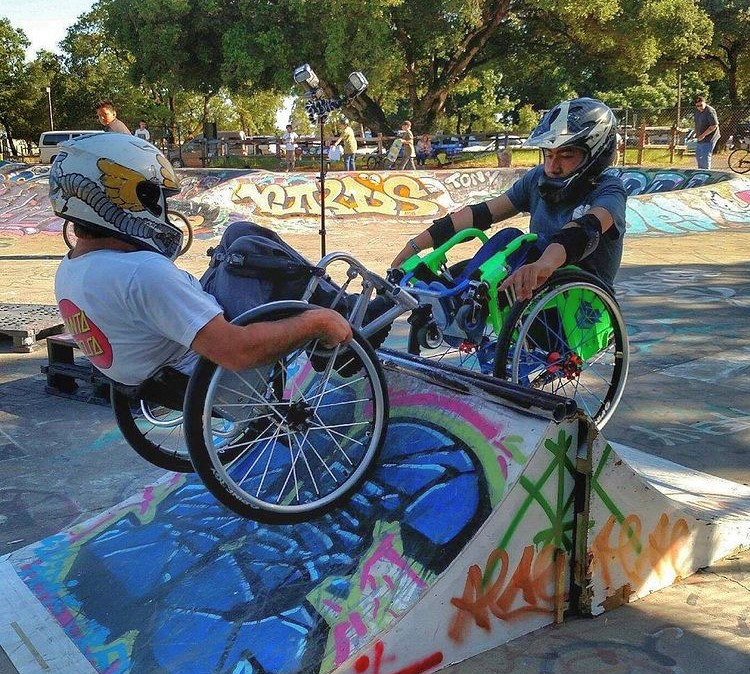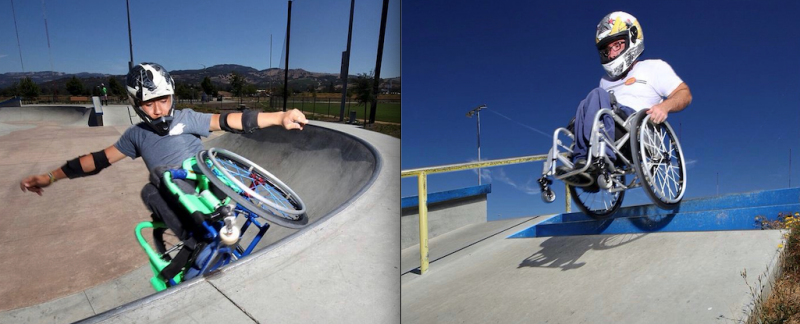Santa Rosa’s Randy Harlan and Bolinas’ Garnett Silver-Hall are known for using wheelchairs the same way others use skateboards– grinding on rails and riding off ramps.
The duo are both adaptive athletes in the “chair skating” community, and founders of Northern California’s Wheelchair Motocross– WCMX.
After connecting through mutual friends, the two have skated at parks in Northern California and competed in Southern California. Now Randy and Garnett teach other folks how to become involved in adaptive sports.
This week we hear how it feels to drop into a bowl at the skatepark and the dangers of attempting a backflip in a wheelchair.

Below are lightly edited excerpts of my conversation with Randy Harlan and Garnett Silver-Hall.
Randy: Some skate parks these days are being built to be more inclusive, more accessible to all- all kinds of riding whether it’s skateboards or bikes or even wheelchairs. So that’s that’s pretty cool. But we tend to judge a park on how good it is for us, you know, what kind of obstacles we can ride on and how easily we can get around it.
Randy: One reason I like my home park here in Santa Rosa is there’s certain sections where you can drop into a bowl and just ride right out on your own and not have to have somebody stand at the top and throw you down a rope or something to climb out.
Randy: I just like to mostly just carve and kind of just go fast and hang on and that’s more my speed. Garnett’s the more brave of us two, I think, throwing the bigger tricks, like hand plants and stuff like that, fun stuff to watch.
Pen: After you two met playing basketball and eventually linking up at the skate park you two established a group, tell me about that.
Garnett: So we formed NorCal WCMX. Basically our idea was to just get more children with disabilities, get them with their chairs at the skatepark. We both knew how much fun we were having, so we wanted to spread that to the community, anybody that wanted to be a part of it.
Pen: Randy, How’d you get into skating? Take me back to when it started for you.
Randy: All my friends were skaters and bike riders growing up. A whole bunch of misfits over there. I fit in perfect… 16 years ago, when I first started riding we didn’t have actual skate chairs, I was just hanging out with my friends at the skatepark, like I said, and I was in my everyday chair and decided to just drop in on a bowl and see how it went and I actually made it. I didn’t eat it that first time, surprisingly. That’s what got me hooked. Just that feeling of just going fast.
Pen: Garnett how do you feel at the skatepark? Do you feel that sense of camaraderie?
Garnett: Like Randy, I grew up with the skate park just a couple of blocks away from my house. I’m from Bolinas, California it’s a small little surf and skate town… I’d get on a skateboard and just sit on it and ride around too, when I was younger… Sled hockey was actually my first sport. Then I started getting the basketball through the same program. [I had] the best coaches in the world, Trooper Johnson was the one to introduce me to wheelchair basketball… Here we are like eight years later. I just received a scholarship on an offer to play basketball at the University of Arizona. That’s currently where I am. I’m playing D1 of a sport I love and you know, getting my education paid for the same time so it doesn’t get much better than that
Pen: Congrats.
Garnett: it’s a dream come true
Pen: What position do you play?
Garnett: Unlike stand up ball, we don’t have the same positions, per say, we have a different system that’s based on your disability. Less severe disabilities will be at the higher end, like a four or five and more more severe disabilities would be at the bottom like a one. So I’m like a 1.5 or 2 but my role is more a picker: setting up ball handlers and shooters for open shots, you know, getting them in a position where they can score.
Pen: That’s a great breakdown, I had never heard that before.
Pen: Are there any myths or stereotypes that you constantly have to dispel or bust?
Randy: Experiencing life as a person with a disability, some people make assumptions about, one thing I can think of is, you know, I mean, younger, adult male and sometimes people assume I was a vet or something, you know, that had served in the military even though I was born with my disability.
Garnett: I think it’s getting a lot better as time goes on. But people just assuming that, you know, people with disabilities can’t do a lot of stuff in life. Disabilities can range from, however severe to you know, however severe. But, I think there’s a lot of things people with disabilities can do that they’re not credited for.

Rightnowish is an arts and culture podcast produced at KQED. Listen to it wherever you get your podcasts or click the play button at the top of this page and subscribe to the show on NPR One, Spotify, Apple Podcasts, TuneIn, Stitcher or wherever you get your podcasts.


